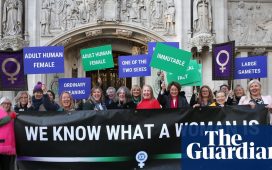“Desperate for mum to die,” I texted my boyfriend in early March 2020. By then my mother, Mary-Anne, had spent months in a nursing home after two years of hospital treatments, surgeries, a ketogenic diet and a daily melange of drugs – all attempts to beat her brain cancer.
As her mobility decreased, my family were grateful to be allocated NHS funding for a bed in a local nursing home. Yet we soon discovered the lousy realities of end-of-life services in England: nursing homes are vastly ill equipped to administer palliative care, and patient decision-making about death is hamstrung by the UK’s restrictive laws on assisted dying.
Though the care workers in Mum’s home were fantastic, staffing levels were too low to allow for sufficient patient check-ins. Mum got frequent headaches, but the cancer’s progression meant she couldn’t remember to press her buzzer for help – instead, she would silently raise her fingers to her temple and frown deeply. Fearful of leaving her lying in pain for hours, my family decided that one of us would need to stay in the room at all times to call for assistance on her behalf.
Five of us set up a rota system around our work commitments, covering 24 hours a day, seven days a week, and laid an air mattress by her bed to sleep on. Though being in the room helped, we weren’t allowed to administer medication ourselves – only to press the buzzer – meaning Mum would often experience an hour-long wait for paracetamol to treat crushing head pain.
My family’s story isn’t a one-off. In the last Office for National Statistics survey of bereaved people, from 2015, only 43% of respondents whose relatives died in care homes said that pain was always relieved in the patient’s final three months. A 2018 academic review highlighted that fractured communication between care homes and external healthcare professionals, such as GPs and district nurses, means care staff are often unsure of who is responsible for providing certain aspects of end-of-life care. These problems are only exacerbated by staff shortages and high turnover in care homes.
Expanded specialist palliative community services are one solution. However, the government has historically been reluctant to pay for high-quality end-of-life care, covering just 37% of hospice bills and leaving the rest to charity fundraising. Yes, specialist care is expensive, but the government is shooting itself in the foot by failing to invest in it: inadequate end-of-life services can mean patients are unnecessarily hospitalised, with the government left to pay the high costs of acute NHS care.
Mum’s end-of-life phase was made worse by a lack of communication about the dying process. In July 2019, when she was hospitalised after a seizure, doctors told her that death would come within weeks and be gentle: she would get more and more tired until she eventually slipped away. By the time she did die, on 30 March 2020, she had endured eight months of pain, seizures, confusion, increasing paralysis and other challenging symptoms, compounded by a decreasing – and eventually nonexistent – ability to communicate how she felt.
The possibility that she might have such a distressing end-of-life phase was never mentioned. This conversation may have been skirted because UK patients facing this scenario have few options: assisted dying is illegal here. If the reality of Mum’s death had been discussed frankly, and the option of assisted dying been made available, I have almost no doubt that she would have chosen that path.
A recent YouGov poll shows that 64% of adults believe UK law should be changed to permit assisted dying for terminally ill patients. Last December, MPs launched an inquiry to look at the ethics of assisted dying and lessons from countries that have legalised the practice. Indeed, assisted dying is rapidly gaining support worldwide, and is now legal in several jurisdictions including Australia, the Netherlands and parts of the United States.
One of the major ethical concerns surrounding assisted dying is that vulnerable individuals, such as some people with disabilities, may end their lives for fear of being a burden to others. However, evidence from the US and the Netherlands suggests that the legalisation of assisted dying has had no disproportionate impact on vulnerable groups. Moreover, a 2019 poll found that 86% of people with a disability support terminally ill adults being given the choice.
The irony is that when the patient cannot choose their end-of-life pathway, decision-making falls to others. In the final months of Mum’s life, she ate only because we woke her up to feed her, which often felt like the wrong thing to do because food made her cough incessantly. “I’ve basically stopped feeding her cos seems like torture,” I wrote in another message to my boyfriend in mid-March 2020.
At that point, we sought guidance from a hospice, which advised us to stop giving her food and water; this is in line with General Medical Council legal guidance to withdraw nutrition and hydration based on what the patient’s “best interests” are believed to be. But should this have happened months earlier? Should the nursing home or GP have suggested we stop sooner? And, crucially, where is the line between stopping feeding somebody and helping someone die? In my view, my family, with the advice of the hospice, made a decision for Mum to die at that arbitrary point in time – we could have withdrawn food sooner, avoiding months of pain, or later, further prolonging her suffering. Dying is rarely a simple process; often difficult decisions must be made by someone, at some point. Putting those choices in the hands of the patient is the only ethical approach.
My worst memory from the nursing home was when the laundry room caught fire. Staff and visitors evacuated, but it was policy to leave patients in their beds, so I abandoned Mum as the earsplitting alarm blared on. From the garden, as we waited a long while for the fire engine to arrive, I looked up to the window of her room and pictured her there – lying alone, probably fearful, perhaps in pain – and thought how this could have all been different, if only she had been able to choose how to die.
-
Ella Creamer is a freelance politics and culture journalist
-
Do you have an opinion on the issues raised in this article? If you would like to submit a response of up to 300 words by email to be considered for publication in our letters section, please click here.











